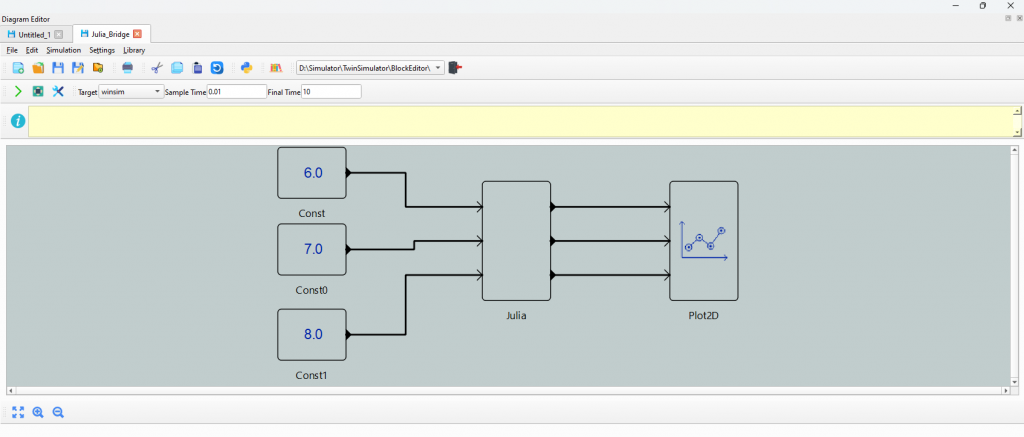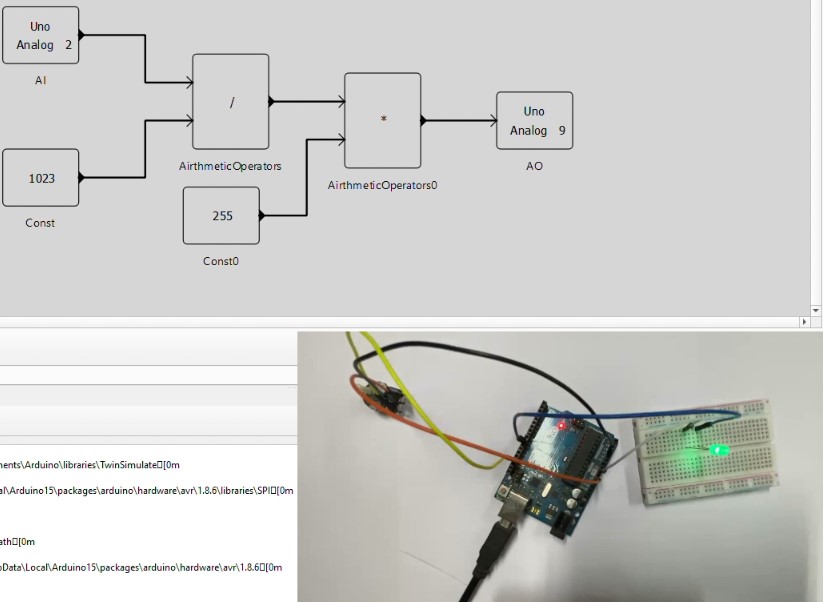We’re thrilled to announce an exciting enhancement to the TwinSimulate : the ability to embed Julia code directly into your block diagrams for model-based simulation. This update bridges the intuitive, visual power of block-diagram-based modeling with the computational flexibility and precision of the Julia programming language. By combining these strengths, TwinSimulate is taking a significant leap forward in empowering engineers, researchers, and developers to craft highly customized, high-performance digital twins tailored to their specific needs.
In this blog, we’ll explore why Julia is a game-changer for technical computing, how this new feature enhances TwinSimulate’s capabilities, and the diverse applications where this integration can shine.

Why Julia? The Power of a Modern Technical Language
Julia is more than just another programming language—it’s a purpose-built tool designed to tackle the demands of scientific computing, numerical analysis, and large-scale simulations. Unlike traditional languages that often force a trade-off between ease of use and performance, Julia delivers both. Here’s what makes it stand out:
- Speed Without Sacrifice: Julia is compiled just-in-time (JIT) using LLVM, offering performance close to C or Fortran while maintaining a syntax as approachable as Python. This means you can write readable code without worrying about sluggish execution—a critical advantage for real-time digital twin simulations.
- Mathematical Expressiveness: With native support for linear algebra, differential equations, and parallel computing, Julia feels like it was tailor-made for engineering and scientific workflows. Its mathematical syntax mirrors how engineers think, reducing the cognitive overhead of translating ideas into code.
- Interoperability: Julia plays well with other ecosystems, allowing you to call Python, C, or MATLAB libraries if needed. This flexibility ensures TwinSimulate users can leverage existing tools while tapping into Julia’s strengths.
- Open-Source Ecosystem: Backed by a thriving community and a rich package ecosystem (e.g., DifferentialEquations.jl, ModelingToolkit.jl), Julia provides a wealth of pre-built tools for simulation, optimization, and machine learning—perfect for digital twin development.
For a platform like TwinSimulate, which thrives on delivering robust, scalable digital twins, Julia’s unique blend of performance and expressiveness makes it an ideal companion.
Enhancing TwinSimulate: Block Diagrams Meet Julia Code
TwinSimulate has always excelled at offering a block-diagram-based approach to digital twin design. This visual paradigm lets users define system components, connect them intuitively, and simulate complex behaviors without diving deep into code. But what if you need to go beyond pre-defined blocks and inject custom logic or advanced mathematics into your model? That’s where our new Julia integration comes in.
With this feature, you can now embed Julia code directly within specific blocks of your TwinSimulate diagrams. Here’s how it works:
- Seamless Integration: Add a “Julia Code Block” to your diagram, write your custom Julia script, and connect it to other blocks. The platform handles the execution, ensuring your code runs as part of the simulation pipeline.
- Dynamic Flexibility: Need a custom differential equation solver, a machine learning model, or a complex control algorithm? Write it in Julia and plug it in—no need to rely solely on pre-built components.
- Real-Time Feedback: TwinSimulate’s simulation engine compiles and executes your Julia code on the fly, letting you tweak parameters and see results instantly within the diagram interface.
Here is a video demonstration of the overall feature in action
This hybrid approach retains the simplicity of block-based modeling while unlocking the full power of programmatic customization. It’s like giving your digital twin a superpower: the ability to adapt to virtually any use case with surgical precision.
Why This Matters: Expanding TwinSimulate’s Capabilities
By integrating Julia into TwinSimulate, we’re not just adding a feature—we’re expanding what’s possible. Users can now:
- Prototype Faster: Quickly implement and test novel algorithms or physics models without leaving the platform.
- Scale Efficiently: Leverage Julia’s high-performance computing capabilities to simulate large, complex systems with minimal overhead.
- Customize Deeply: Tailor every aspect of your digital twin, from low-level physics to high-level decision-making logic, all within a single workflow.
This feature preserves TwinSimulate’s user-friendly ethos while catering to advanced users who crave more control. Whether you’re a systems engineer designing a next-gen HVAC system or a data scientist building a predictive maintenance model, Julia integration empowers you to push boundaries.
Real-World Applications: Where Julia + TwinSimulate Shines
Let’s dive into some practical scenarios where this feature can make a difference:
- Industrial Equipment Optimization
Imagine modeling a factory conveyor system. With TwinSimulate’s block diagrams, you can define the conveyor’s components—motors, belts, sensors—and their interactions. Now, add a Julia Code Block to implement a custom optimization algorithm that adjusts motor speeds based on real-time load data. The result? A digital twin that not only mirrors the physical system but actively improves its efficiency. - Aerospace Dynamics
For an aircraft wing under varying aerodynamic loads, you might use TwinSimulate to model structural components visually. Embed Julia code to solve partial differential equations describing stress and strain, incorporating real-world sensor data. This hybrid model can predict failure points with high accuracy, all while keeping the workflow intuitive. - Energy Systems and Renewables
Building a digital twin of a wind turbine? Use TwinSimulate’s blocks to represent the turbine, generator, and grid connection. Then, integrate Julia code to simulate turbulent wind patterns or optimize blade pitch control using machine learning. This level of detail can enhance energy output predictions and maintenance schedules. - Healthcare Simulations
In biomedical engineering, a digital twin of a patient’s circulatory system could use block diagrams for high-level flows (heart, arteries, veins). Add Julia code to model blood flow dynamics with Navier-Stokes equations or predict clot formation risks based on patient-specific data. The possibilities for personalized medicine are vast.
Looking Ahead
The addition of Julia code integration marks a pivotal moment for TwinSimulate. It’s a testament to our commitment to balancing accessibility with power, ensuring that users of all backgrounds—whether GUI-driven designers or code-savvy researchers—can build digital twins that meet their exact needs. As we continue to refine this feature, we’re excited to see how our community leverages it to solve real-world challenges.
Ready to explore this new capability? Dive into TwinSimulate today, experiment with Julia in your diagrams, and let us know how it transforms your digital twin projects. The future of simulation is here—and it’s more flexible than ever.






